|
|
 |
|
Cyclopoida ( Order ) |
|
|
|
Oithonidae ( Family ) |
|
|
|
Oithona ( Genus ) |
|
|
| |
Oithona attenuata Farran, 1913 (F,M) | |
| | | | | | | Syn.: | Oithona attenuata var. latithoracica Früchtl, 1923 (p.454); 1924 b (p.71, fig., Rem.);
Oithona ovata Lindberg, 1950 (p.261); Lindberg, 1955 a (p.467: Rem.); Shuvalov, 1980 (p.149, figs.F) | | | | Ref.: | | | Farran, 1913 a (p.187, figs.F); Rosendorn, 1917 (p.303); 1917 a (p.42, figs.F,M); Früchtl, 1924 b (p.70, 72, fig., Rem.); Kiefer, 1929 g (p.8, Rem.F,M); Farran, 1936 a (p.124); Sewell, 1947 (p.253); Tanaka, 1960 (p.56, figs.F); Wellershaus, 1970 (p.480); Kos, 1972 (Vol.I, figs.F, Rem.); Chen & al., 1974 (p.34, figs.F, p.74: Rem.); Nishida & al., 1977 (p.128, figs.F, Rem.); Shuvalov, 1980 (p.154, figs.F); Nishida, 1985 a (p.21, figs.F,M, Rem., p.138); Böttger-Schnack, 1988 (p.313, Rem.); Yoo & Lim, 1993 (p.91, 93, 100, Table 1), Kim & al., 1993 (p.271); Chihara & Murano, 1997 (p.936, Pl.198, 203: F,M); Bradford-Grieve & al., 1999 (p.886, 966, figs.F); McKinnon, 2000 (p.108, Rem.); Al-Yamani & Prusova, 2003 (p.100, figs.F,M); Conway & al., 2003 (p.203, figs.F,M, Rem.); Vives & Shmeleva, 2010 (p.48, 50, 83, figs.F,M, Rem.); Al-Yamani & al., 2011 (p.96, figs.F,M), Rosa & al., 2019 (p.3, 4, figs.F, Rem.) | 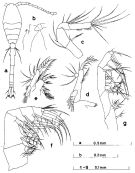 Issued from : S. Nishida in Bull. Ocean Res. Inst., Univ. Tokyo, 1985, No 20. [p.22, Fig.5]. As Oithona attenuata typical form. Female: a, habitus (dorsal); b, forehead (lateral); c, A2; d, Md; e, Mx1; f, Mx2; g, Mxp. Nota: The typical form coincides with the descriptions of Farran (1913) and Früchtl (1924) and Nishida & al. (1977).
|
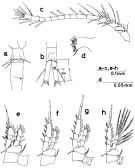 Issued from : S. Nishida in Bull. Ocean Res. Inst., Univ. Tokyo, 1985, No 20. [p.23, Fig.6]. As Oithona attenuata typical form. Female:a, last thoracic segment 5 and gental segment (lateral left side); b, Anal segment and caudal rami (dorsal); c, A1; d, Md (biting edge); e, P1; f, P2; g, P3; h, P4.; W = width, L = length, Csi = distance between distal margin of caudal ramus and base of outer marginal seta measured parallel to the longitudinal axis of caudal ramus.
|
 Issued from : S. Nishida in Bull. Ocean Res. Inst., Univ. Tokyo, 1985, No 20. [p.25, Fig.7]. As Oithona attenuata stocky form. Female: a, habitus (dorsal); b, forehead (lateral); c, last thoracic segment 5 and genital segment (dorsal); d, idem (lateral left side); e, anal segment and caudal rami (ventral); f, A1; g, Md; h, Mx1. Nota: This form is referable to O. attenuata var. lathithoracica Früchtl (1923; 1924) and O. ovata Lindberg (1950).
|
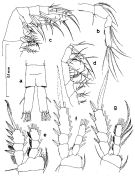 Issued from : S. Nishida in Bull. Ocean Res. Inst., Univ. Tokyo, 1985, No 20. [p.26, Fig.8]. As Oithona attenuata stocky form. Female: a, caudal rami (dorsal); b, A2; c, Mx2; d, Mxp; e, P1; f, P2; g, P4.
|
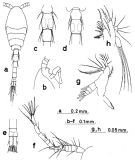 Issued from : S. Nishida in Bull. Ocean Res. Inst., Univ. Tokyo, 1985, No 20. [p.27, Fig.9]. As Oithona attenuata stocky form. Male: a, habitus (dorsal); b, forehead (lateral); c, genital segment (ventral); d, idem (dorsal); e, anal segment and caudal rami (dorsal); f, A1; g, Md; h, Mx1.
|
 Issued from : S. Nishida in Bull. Ocean Res. Inst., Univ. Tokyo, 1985, No 20. [p.28, Fig.10]. As Oithona attenuata stocky form. Male: a, genital segment (lateral left side); b, A2; c, Mx2; d, Mxp; e, P1; f, P2; g, P4.
|
 Issued from : S. Nishida in Bull. Ocean Res. Inst., Univ. Tokyo, 1985, No 20. [p.29, Table 2.]. Variation of length and body proportions of female Oithona attenuata reported by previous workers and calculated by Nishida. For Nishida the typical form has longer body, greater length to width ratio in prosome, and smaller prosome to urosome length ratio than the stocky form (See Table 2).
|
 issued from : Q.-c Chen & S.-z. Zhang & C.-s. Zhu in Studia Marina Sinica, 1974, 9. [Pl.2, Figs.13-15]. Female (from China Seas): 13, habitus (dorsal); 14, forehead (lateral); 15, P1.
|
 issued from : Q.-c Chen & S.-z. Zhang & C.-s. Zhu in Studia Marina Sinica, 1974, 9. [Pl.3, Figs.1-3]. Female: 1, P2; 2, P3; 3, P4.
|
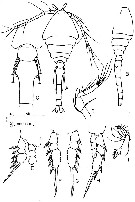 issued from : F.Y. Al-Yamani & I. Prusova in Common Copepods Northwestern Arabian Gulf : Identification Guide. Kuwait Institute for Scientific Research, 2003. [p.101, Fig.36]. Female: A, habitus (dorsal); B, idem (lateral left side); C, urosmal segments 1 and 2 (dorsal); D, A2; E, exopod of P1; F, exopod of P2; H, exopod of P3; I, Md (mandibular palp). Nota: Prosome 1.5 times width, 1.0 times urosome. Present specimens agree with Nishida's (1985) description of O. attenuata stocky form.
|
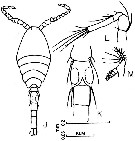 issued from : F.Y. Al-Yamani & I. Prusova in Common Copepods Northwestern Arabian Gulf : Identification Guide. Kuwait Institute for Scientific Research, 2003. [p.102, Fig.37]. Male: J, habitus (dorsal); K, urosomal segments 1-3 (ventral); L, A2; M, Md (mandibular palp). Nota: Prosome length 1.9 times width, 1.2 tmes urosome. P6 with 2 subequal short setae, extending to posterior end of urosomal segment 3.
|
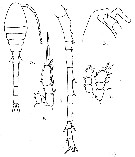 issued from : G.P. Farran in Proc. zool. Soc. Lond., 1913. [Plate XXX, Figs.3-7]. Female (from Christmas Island, Indian): 3, forehead (lateral); 4, A1: 5, habitus (dorsal); 6, P3; 7, P1.
|
 issued from : I. Rosendorn in Wiss. Ergebn. dt. Tiefsee-Exped. \"Valdiviella\", 1917, 23. [p.43, Fig.25]. Female: a, Md. Nota: Proportion of lengths (p.cent) Prosome : 47.26, Urosome : 52.74 . Relative lengths of urosomal segments and caudal rami: 5 : 18 : 8 : 9 : 6 : 8. Setal formula of the exopod swimming legs P1 to P4 (Se = outer setae), P1 : 1, 1, 3 Se ; P2 : 1, 1, 3 Se; P3 : 1, 1, 3 Se ; P4 : 1, 1, 2 Se. Male: b, habitus (dorsal); c, exopod of P1; d, exopod of P2; e, urosome; f, exopod of P3; h, Md. Nota: Proportion of lengths (p.cent) Prosome : 50.94, Urosome : 49.06 . Relative lengths of urosomal segments and caudal rami: 6 : 11 : 9 : 8 : 6.5 : 7.5 : 9. Setal formula of the exopod swimming legs P1 to P4 (Se = outer setae), P1 : 1, 1, 3 Se; P2 : 1, 1, 3 Se ; P3 : 1, 1, 3 Se ; P4 : 1, 1, 2 Se.
|
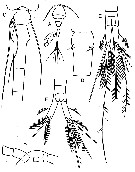 issued from : V.S. Shuvalov in Opred. Faune SSSR, Nauka, Leningrad, 1980, 125. [p.150, Fig.42]. As Oithona ovata. After Lindberg, 1950. Female: A, habitus (dorsal); B, forehead (ventral); C, end of prosome and urosome (dorsal); D, genital segment; E, anal segment and caudal rami; F, same.
|
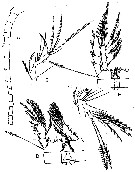 issued from : V.S. Shuvalov in Opred. Faune SSSR, Nauka, Leningrad, 1980, 125. [p.151, Fig.43]. As Oithona ovata. After Lindberg, 1950. Female: A, A1; B, A2; C, Md; D, P1; E, P4.
|
 issued from : V.S. Shuvalov in Opred. Faune SSSR, Nauka, Leningrad, 1980, 125. [p.131, Fig.32, 1-8]. Female: 1, 3, habitus (dorsal and lateral, respectively); 2, A1; 4-5, forehead (lateral and dorsal); 6-7, thoracic segments 4 and 5, genital segment (dorsal and lateral, respectively); 8, posterior part of urosome (dorsal).
|
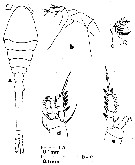 Issued from : S. Nishida, O. Tanaka & M. Omori in Bull. Plankton Soc. Japan, 1977, 24 (2). [p.129, Fig.3]. Female (from Suruga Bay and adjacent waters): a, habitus (dorsal), b, forehead (lateral); c, Md; d, P1; e, P2. Nota: Setae formula of exopod P1 to P4 (outer setae in first, inner setae in second). P1: 1,1,3; 1,1,4. P2: 1,1,3; 1,1,5. P3: 1,1,3; 1,1,5. P4: 1,1,2; 1,1,5. Prosome length/urosome length = 0.82-0.87.
|
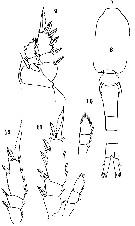 Issued from : O. Tanaka in Spec. Publs. Seto mar. biol. Lab., 10, 1960 [Pl. XXIV, 7-12]. Female (from 0°08'S, 76°15'E): 7, forehead (dorsal); 8, urosome (dorsal); 9, P1; 10, endopod of P2; 11, P3; 12, exopod of P4. Nota: Prosome and urosome in the proportional lengths 52 to 48. Rostrum absent. Urosomal segments and caudal rami in the proportional lengths 12 : 29 : 15 : 14 : 13 : 17 = 100.
|
 Issued from : O. Tanaka in Spec. Publs. Seto mar. biol. Lab., 10, 1960 [Pl. ]. Female: Number of outer marginal spine and inner marginal setae on the exopod of P1 to P4.
|
 Issued from K.-I. & D.-H. Lim in The Korean J. Syst. Zool., 1993, 9 (2). [Key of female]: ]Morphological characters of Oithona attenuata female in Korean waters :
1 - Anterior part of prosome rounded in dorsal view.
2 - Rostrum blunt. 3 - P5 with 1 seta. 4 - Length of A1 same as that of prosome. 4 - Length of 1st spine in inner lobe 1 of Mx1 more than 2 times of that of other spines.
|
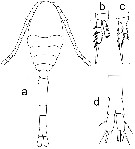 Issued from : J. da Cruz Lopes da Rosa, W.M. Monteiro-Ribas, L. Lemos Batista & L. Dias de Almeida Fernandez in Naoplius, 2019, 27: e2019001. [p.3, Fig.2]. Oithona attenuata Female (from Cabo Frio Island: 22°59'86''S, 42°00'28''W): a, habitus (dorsal); b, P3; c, P4; d, last urosomal segments and caudal rami.
Nota: Temperature approximately 24.4 °C and 35.9 psu at the end of the austral summer (March) and approximately 21.5 °C and 34.5 psu in autumn (May). The higher abundance (125 ind. per m3) in more saline waters.
Nota: - Ratio prosoe : urosome = 0.856.
- Forehead not produced into pointed rostrum
- P1 exopodite and endopodite 3-segmented.
- P1-P4: exopodite outer spine formula otherwise arranged (Oithona).
- P4 exopodite with 2 outer spines.
- P5: free segment with only 1 terminal seta or 1 terminal seta and 1 marginal spinule.
- Md with 1 strong spinulose spine and 1 fine seta on distal end.
- Mx1 endopod with 4 setae.
- Mx2 with inner lobe 1 with distal marginal setae about twice longer than other setae.
- Caudal rami about 4 times longer than wide, with 6 plumose setae.
For the authors, this species may have come from the Indian Ocean from a whirlwind and arriving in Brazil (according to Villar & al. (2015) plankton can be transported by Agulhas rings escaping the Indian Ocean, entering Cape Basin, and drifting northwesterly across the South Atlantic, and finally reaching the South American continent over the course of several years). The absence of more individuals in samples collected during ongoing monitoring in the following months lead to conclude that O. attenuata did not successfully reach the status of an introduced species. This species is the first record in Brazil, from a coastal station in March and May 2011.
| | | | | Compl. Ref.: | | | Wilson, 1942 a (p.196); Fagetti, 1962 (p.38); De Decker & Mombeck, 1964 (p.13); Delalo, 1968 (p.138); Dussart, 1984 (p.25, 64: occurrence): Kimmerer & McKinnon, 1985 (p.150); Othman & al., 1990 (p.561, 564, Table 1); Yoo, 1991 (tab.1); McKinnon, 1991 (p.471); Shih & Young, 1995 (p.74); McKinnon & Ayukai, 1996 (p.595); Noda & al., 1998 (p.55, Table 3, occurrence); Suarez-Morales & Gasca, 1998 a (p.111); Ueda & al., 2000 (tab.1); Ueda, 2001 (p.96, as ''srocky form'', occurrence); Uysal & al., 2002 (p.18, tab.1); McKinnon & al., 2003 (p.101, tab.2, fig.11); Hsieh & al., 2004 (p.397, tab.1); Rezai & al., 2004 (p.486, tab. 2, 3, abundance, Rem.); Lo & al., 2004 (p.468, tab.2); Hwang & al., 2005 (p.106); Zuo & al., 2006 (p.159, tab.1, abundance, fig.8: stations group); Hwang & al., 2006 (p.943, tabl. I); Hwang & al., 2007 (p.25); Tseng L.-C. & al., 2008 (p.153, fig.5, Table 2, occurrence vs geographic distribution, indicator species); McKinnon & al., 2008 (p.843: Tab.1, fig.7); Hwang J.-S. & al., 2010 (p.220, Table 2, fig.3, 4, %, abundance); Hernandez-Trujillo & al., 2010 (p.913, Table 2); Fazeli & al., 2010 (p.153, Table 1); Hsiao S.H. & al., 2011 (p.475, Appendix I); Chew & Chong, 2011 (p.127, Table 3, abundance vs location); Zhang G.-T. & Wong, 2011 (p.277, fig.6, 7, abundance, indicator); Kâ & Hwang, 2011 (p.155, Table 3: occurrence %); Tseng L.-C. & al., 2011 (p.47, Table 2, occurrences vs mesh sizes); Saitoh & al., 2011 (p.85, Table 5); Beltrao & al., 2011 (p.47, Table 1, density vs time); Uysal & Shmeleva, 2012 (p.909, Table I); Zamora-Terol & Saiz, 2013 (p.376, Rem.: Table 3, egg production); in CalCOFI regional list (MDO, Nov. 2013; M. Ohman, comm. pers.); Tseng & al., 2013 (p.507, seasonal abundance); Zamora Terol, 2013 (p.163, 164: Table 2, 3, 4: clearance rates vs. diets, ingestion, egg production, Table 5: fecundity); Hwang & al., 2014 (p.43, Appendix A: seasonal abundance); Ben Ltaief & al., 2017 (p.1, Table III, Summer relative abundance) | | | | NZ: | 12 + 1 doubtful | | |
|
Distribution map of Oithona attenuata by geographical zones
|
| | | | | | | | | | | |  Issued from : S. Nishida in Bull. Ocean Res. Inst., Univ. Tokyo, 1985, No 20. [p.138, Fig.89]. Issued from : S. Nishida in Bull. Ocean Res. Inst., Univ. Tokyo, 1985, No 20. [p.138, Fig.89].
Indo-Pacific geographical distribution of Oithona attenuata |
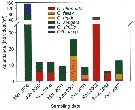 Issued from : J.-S. Hwang, R. Kumar, H.-U. Dahms, L.-C. Tseng & Q.-C. Chen in Zool. Studies, 49 (2). [p.224, Fig.3). Issued from : J.-S. Hwang, R. Kumar, H.-U. Dahms, L.-C. Tseng & Q.-C. Chen in Zool. Studies, 49 (2). [p.224, Fig.3).
Average abundances of six Oithona species recorded in the South China Sea from Mar. 2000 to Oct. 2002.
Sampling stations between 16-24° N, 114-120° E. |
 Issued from : S. Zamora Terol in Tesis Doc. Univ. Politèc. Catalunya, 2013 [p.82-83, Table 3]. Issued from : S. Zamora Terol in Tesis Doc. Univ. Politèc. Catalunya, 2013 [p.82-83, Table 3].
Comparison of egg production and clutch sizes among different species of Oithona from field and lab studies.
Also, see: Oithona aruensis, O. colcarva, O. davisae, O. nana, O. plumifera, O. setigera, O. similis, O. simplex. |
 Issued from : S. Zamora Terol in Tesis Doc. Univ. Politèc. Catalunya, 2013 [p.163, Table 2]. Issued from : S. Zamora Terol in Tesis Doc. Univ. Politèc. Catalunya, 2013 [p.163, Table 2].
Feeding experiments in the Whitsunday Islands area (Great Barrier Reef lagoon, Northeastern Australia). The initial prey concentration (in cells and biomass), clearance rates (mL female-1 day-1), and ingestion rates (in cells and % body carbon ingested.
Asterisks (*) indicate significant feeding rates.
See Oithona cf. dissimilis. |
 Issued from : S. Zamora Terol in Tesis Doc. Univ. Politèc. Catalunya, 2013 [p.165, Table 3]. Issued from : S. Zamora Terol in Tesis Doc. Univ. Politèc. Catalunya, 2013 [p.165, Table 3].
Fecondity experiments in the Whitsunday Islands area (Great Barrier Reef lagoon, Northeastern Australia).
Prosome length (PL, -1),. The egg production efficiency (GGE %).
See Oithona cf. dissimilis. |
 Issued from : S. Zamora Terol in Tesis Doc. Univ. Politèc. Catalunya, 2013 [p.164, Fig. 3]. Issued from : S. Zamora Terol in Tesis Doc. Univ. Politèc. Catalunya, 2013 [p.164, Fig. 3].
Relationship between weight-specific egg production (SEPR, % day-1) and weight-specific ingestion (WSI, % day-1 on protozooplankton.
Linear regression fit to the data in Table 3 for O. attenuata and Oithona cf. dissimilis.
See: Fecondity experiments in the Whitsunday Islands area (Great Barrier Reef lagoon) and Townsville mangrove ( Northeastern Australia).
The egg production efficiency (i.e. gross growth efficiency, GGE) varied among experiments between 13 and 67%. An average of 40% was estimated from the slope of the linear regression between SEPR and WSIR. |
| | | | Loc: | | | South Africa (Cape of Good Hope, Eastern), Cabo Frio Island (SW Brazil), Atlant. (sporadic after Rosendorn), E Medit. (G. of Gabes, Lebanon Basin), Red Sea, Gulf of Oman, Arabian Sea, Arabian Gulf, Maldives Is., Madagascar (Nosy Bé), Seychelles, Indian, Nicobar Is., Christmas Is., Straits of Malacca, Sangga estuary (mainly nearshore and off shore), Indonesia-Malaysia, Samoa (Pago Pago Harbour), China Seas (Yellow Sea, East China Sea, South China Sea), Hong Kong, Pa-Li, off SW Taiwan, Taiwan (E, S, W, NE, Tapong Bay, Danshuei Estuary), Okinawa (lagoons), Korea (E, S & W), S Japan (Kuchinoerabu Is.), Japan, Ariake Bay, Palau Is., Pacif. tropical (W & central), W Baja California (Bahia Magdalena), Australia (Melbourne, Great Barrier Reef, Exmouth Gulf, North West Cape, G. of Carpentaria), off Chile | | | | N: | 59 | | | | Lg.: | | | (34) F: 1,78; (66) F: 0,8; (109) F: 0,85-0,76; (155) F: 0,88-0,84; (627) F: 0,84-0,78; 0,72-0,66; M: 0,55-0,52; (634) F: 0,88; (937) F: 0,65-0,69; M: 0,52-0,54; (649) F: 0,72-0,82; M: 0,53; (880) F: 0,81-0,82; 0,72-0,87; M: 0,53; (991) F: 0,78-0,84; M: 0,53; (1085) F: 0,6-0,8; M: 0,5-0,6; (1227) F: 0,62-0,63; {F: 0,60-1,78; M: 0,50-0,60} | | | | Rem.: | epipelagic.
Given prominence to the 2 forms:
Oithona attenuata latithoracica Früchtl,1923 (F)
Ref.: Früchtl, 1923 (p.451, 454); 1924 b (p.22, 71, fig.); Nishida, 1985 a (p.21, 29); 1986 a (p.914); Othman & al., 1990 (p.561, 564, Table 1);
Loc.: Indien, I. Christmas, Is., Australia (G. of Carpentaria), Aru, mers de Chine, Japon
.
Oithona attenuata latithoracica f. trisetosa Früchtl,1923 (F)
Ref.: Früchtl, 1923 (p.451, 455); 1924 b (p.73)
Loc.: Is. Aru.
See in Oithona robertsoni Table 2 from McKinnon (2000, p.108).
See in DVP Conway & al., 2003 (version 1)
| | | Last update : 19/06/2023 | |
|
|
 Any use of this site for a publication will be mentioned with the following reference : Any use of this site for a publication will be mentioned with the following reference :
Razouls C., Desreumaux N., Kouwenberg J. and de Bovée F., 2005-2025. - Biodiversity of Marine Planktonic Copepods (morphology, geographical distribution and biological data). Sorbonne University, CNRS. Available at http://copepodes.obs-banyuls.fr/en [Accessed August 29, 2025] © copyright 2005-2025 Sorbonne University, CNRS
|
|
 |
 |

























